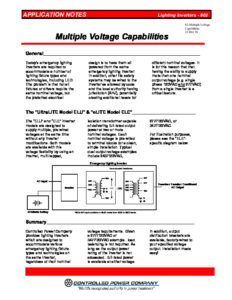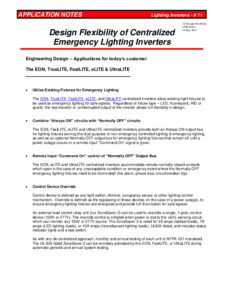UltraLITE Model ELC
(600W to 2kW)
Description:
The UltraLITE Model ELC’s compact front access design features one of the smallest cabinet footprints in the industry!
Meeting the NFPA 101 and NFPA 111 standards, the Model ELC is considered “Life Safety Equipment.” It is also UL 924 listed as “Emergency Lighting Equipment,” providing the required 90 minutes of emergency backup power, and is 100% compatible with all lighting applications and life safety systems. The Model ELC’s voltage regulation and performance characteristics extend ballast, LED driver, and lamp life, which make this product an advantageous choice over competing lighting inverters.
Whether fed from the AC power source or even while in battery mode, the ELC has a peak overload capability of 1200% to accommodate inrush current from LED fixtures!
Single Phase Sizes: 600W, 1kW, 1.5kW, 2kW.

- Automatic self-testing, data logging, and reporting per NFPA 101 – 7.9.3.1.3.
- Uninterrupted, regulated, continuous sine wave output for use with “normally on” lighting fixtures and exit lamps, LED and HID compatible
- Standby output for use with “normally off” emergency lighting fixtures
- Timed Normally Off Bus “PLUS” option includes an adjustable soft start to accommodate the high inrush current of “normally off” emergency lights.
- True, online double-conversion topology provides conditioned, regulated power and 100% reliability to emergency lighting loads
- High-speed automatic static bypass
- Manual bypass switch
- Advanced DSP control used for enhanced performance, accuracy, and system reliability
- Standard NEMA 2 drip-proof enclosure
- One (1) Output Circuit Breaker included for the “Normally On” bus and/or the “Timed Normally Off” bus.
- A total of (12) circuit breakers or (6) monitored circuit breakers are available (120V or 277V), and can be factory-wired to the “Normally On” bus and/or optional “Normally Off” bus, in any combination specified.
- Generator compatible
- 4-stage, temperature-compensated battery charger for increased battery life
- An industry-leading battery recharge time of 24 hours or better
- Optional NetMinder Ethernet/MODBUS/BACnet adapter for remote monitoring
- Input Operating Voltage Range: +12%, -30% typical, load-dependent, without battery usage; +12%, -15% at full load
- Input Frequency: 60 Hz, ± 2.5%
- Input Current Harmonic Distortion: < 5% THD
- Input Power Factor Correction: > .97 pF at full load
- Output Sine Wave Voltage: Typically 3% output THD with linear load
- Output Regulation: Typically better than ± 2%
- Overload: Up to 125% for 30 cycles, 150% for 4 cycles when fed from the AC power source, or on battery (without use of static bypass)
- LED Inrush Rating: Peak overload capability of 1200% to accommodate inrush current from LED fixtures (without the use of static bypass)
- Operating Temperature: 20º to 35º C (for “UL 924 Emergency Lighting Equipment” Listed models); Optimum battery performance and life at 25º C
- Operating Temperature: 0º to 40º C (for “UL 924 Auxiliary Lighting and Power Equipment” Listed models); Optimum battery performance and life at 25º C
- Operating Temperature: 10º to 40º C (for models that are C-UL Listed to CSA C22.2 No. 141-02); Optimum battery performance and life at 25º C
- Inverter electronics designed for use at 0º to 40º C
- Battery Time: UL 924 Listed 90 minutes at full-rated kW output, or with optional run times from 15 minutes to 4 hours, C-UL Listed to CSA C22.2 No. 141-02 with 30 minutes run time
- Audible Noise: < 50 dB
- Schools/Universities/Dormitories
- Arenas/Stadiums
- Parking Structures/Garages
- Hospitals/Clinics
- Office Buildings
- Shopping Malls
- Hotels/Motels
- Apartment Buildings
- Correctional Facilities
- Worship Facilities
Learn more about this product! Read our brochures and other supporting documents!
- What are centralized lighting inverters and why use them?
- Is the UltraLITE Model ELC NFPA 101 compliant?
- Is the UltraLITE Model ELC capable of operating both normally off and normally on lighting fixtures?
- When supplying power to normally off emergency lights, are there any application issues to consider?
- Can all inverter systems handle the high inrush current associated with energizing normally off emergency fixtures?
- Is the UltraLITE Model ELC a fast transfer lighting inverter system?
- Is it important that lighting inverter systems provide a regulated output to emergency fixtures?
- Does the UltraLITE Model ELC preserve battery life?
- Does the UltraLITE Model ELC have a transfer time, and if so, is it important?
Controlled Power Company warrants the UltraLITE Model ELC Emergency Lighting Inverter to be free from defects in material and workmanship for a period of two (2) years following shipment from the factory. Batteries are warranted with a one (1) year full replacement, and 14 year pro-rated warranty. Controlled Power Company agrees to replace, F.O.B. its factory, any parts which fault through defect in material or workmanship during the warranty period.
Warranty begins from date of shipment unless a factory start-up is purchased, then the warranty begins from date of start-up or 90 days from ship date; whichever comes first.
Consult the factory for additional warranty details, and a description of start-up services provided.






 Model ELC General Specification
Model ELC General Specification










